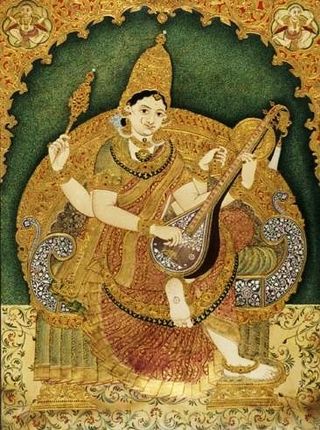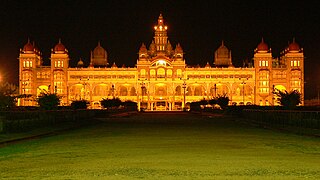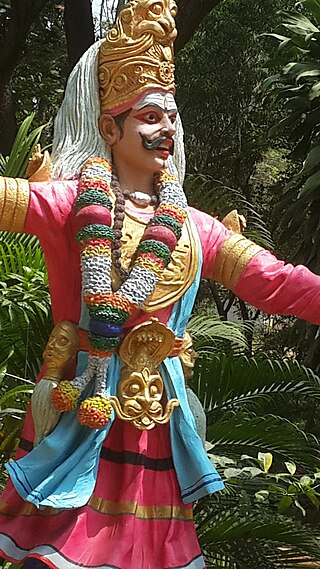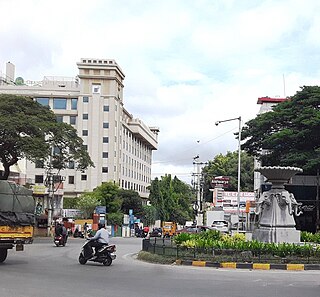
Gowri MN (born 30 August 1989) is an Indian sand artist from Mysore, Karnataka who has been working with sand for over seven years. She is the only female sand sculpture artist in India. [1] [2]

Gowri MN (born 30 August 1989) is an Indian sand artist from Mysore, Karnataka who has been working with sand for over seven years. She is the only female sand sculpture artist in India. [1] [2]
Gowri has an MFA in sculpture from Karnataka State Open University. She has a diploma in machine tool technology, but discontinued engineering to pursue a career in sand sculpting. [3]
Gowri created a sand museum using 115 truckloads of construction sand (river sand). About 150 sculptures have been created on 16 themes, including religion, astrology, and mythology, at the 13,500 sq ft museum. [4] [5] [6]

Mysore, officially Mysuru, is the second-most populous city in the southern Indian state of Karnataka. It is the headquarters of Mysore district and Mysore division. As the traditional seat of the Wadiyar dynasty, the city functioned as the capital of the Kingdom of Mysore for almost six centuries. Known for its heritage structures, palaces, and its culture, Mysore has been called the "City of Palaces", the "Heritage City", and the "Cultural capital of Karnataka". It is one of the cleanest cities in India according to the Swachh Survekshan.

Sand art is the practice of modelling sand into an artistic form, such as sand brushing, sand sculpting, sand painting, or creating sand bottles. A sandcastle is a type of sand sculpture resembling a miniature building, often a castle. The drip castle variation uses wet sand that is dribbled down to form organic shapes before the sands dries.

Gangubai Hangal was an Indian singer of the khayal genre of Hindustani classical music from Karnataka, who was known for her deep and powerful voice. Hangal belonged to the Kirana gharana.

Mysore pak is an Indian sweet prepared in ghee. It originated in the city of Mysore, one of the major cities in the Indian state of Karnataka. It is made of generous amounts of ghee, sugar, gram flour, and often cardamom. The texture of this sweet is similar to a buttery and dense cookie. It is also popular in the neighbouring countries Pakistan and Bangladesh.

Dharmasthala Veerendra Heggade is an Indian philanthropist and the hereditary administrator of the Dharmasthala Temple. He succeeded to the post at the age of 19, on 24 October 1968, the 21st in his line. He administers the temple and its properties, which are held in trust for the benefit of devotees and of Dharma. He is a nominated Member of Parliament in the Rajya Sabha since July 2022.

Tirumakudalu Narasipura the temple city of Karnataka, commonly known as T. Narasipura or T.N. Pura, is a town in Mysore district in the Indian state of Karnataka. The first name refers to the land at the confluence, (trimakuta in Sanskrit at the confluence of the Kaveri, Kabini and Spatika Sarovara. The city is a Taluk of Mysore district and 32 km south-east of the district headquarters and has five Hobli centers. This taluk is bordered by Chamarajanagar district to the south and Mandya districts to the north with an area of 598 sq km. Agriculture is the main occupation of the people here. Rice is the main food crop and silk is the main commercial crop. Fossils of Neolithic age have been found by excavation in some lands of this Taluk. Vyasatirtha, the guru of Purandara Dasa, and T Chowdiah, the unique violinist, were born in this Taluk. Talakad, the capital of the Western Ganga dynasty, is in this Taluk.

Mysore painting is an important form of classical South Indian painting style that originated in and around the town of Mysore in Karnataka. The painting style was encouraged and nurtured by the Mysore rulers. Painting in Karnataka has a long and illustrious history, tracing its origins back to the Ajanta Caves period. The distinct school of Mysore painting evolved from the paintings during the Vijayanagara Empire period, the rulers of Vijayanagara and their feudatories encouraged literature, art and architecture as well as religious and philosophical discussions. With the fall of the Vijayanagara Empire after the 1565 Battle of Talikota, the artists who were until then under royal patronage migrated to various places such as Mysore, Tanjore and Surpur among others. Absorbing the local artistic traditions and customs, the erstwhile Vijayanagara school of painting gradually evolved into the many styles of painting in South India, including the Mysore and Tanjore schools of painting.

Mysore is a city in the state of Karnataka, India. It is known as the cultural capital of Karnataka. Mysore was the capital of the Wodeyar kings who ruled over the Mysore Kingdom for many centuries. Wodeyars were great patrons of art and music and have contributed significantly to make Mysore a cultural centre. Mysore is well known for its palaces, museums and art galleries and the festivities that take place here during the period of Dasara attract a worldwide audience. Mysore has also lent its name to popular dishes like Mysore Masala Dosa and Mysore Pak. Mysore is also the origin of the popular silk sari known as Mysore silk sari and has also given rise to a popular form of painting known as Mysore painting.

Mysore Manjunath, is an Indian violinist. The son and disciple of violinist Vidwan S. Mahadevappa, Manjunath performed his first concert at the age of eight in Mysore as a child prodigy. He is one of the Mysore brothers duo. He is honored with the Sangeet Natak Akademi Award by government of India, bestowed by the president of India at the Rashtrapathi Bhavan in New Delhi.
Nilambur–Nanjangud line also called The golden I. T. corridor or Wayanad Railway, is a railway project to create a 5 ft 6in broad gauge rail connection from the town of Nanjangud (Karnataka) to Nilambur (Kerala) through Wayanad district of Kerala and Nilgiri district of Tamil Nadu.

Manjusha Museum is situated in the holy town of Dharmasthala in Karnataka state, India. It houses a good collection of objects, antiques, paintings, artifacts, temple chariots, vintage and classic cars. These were collected from temples across Karnataka. The museum is located to the south of the famous Lord Manjunatha temple.

Eradu Kanasu is a 1974 Indian Kannada-language romantic drama film directed by the duo Dorai–Bhagavan, and is based on the novel of the same name by Vani. The film stars Rajkumar, Kalpana and Manjula.

Janapada Loka, is a folk museum that has an exclusive display of the village folk arts of Karnataka. It is under the aegis of the Karnataka Janapada Parishat. Loka Mahal, a wing in the museum has a display of 5,000 folk artifacts. It is situated in Ramanagara, Ramanagara district in the Indian state of Karnataka, on the Bangalore-Mysore highway, 53 kilometres (33 mi) to the south of Bangalore.

Dr. T. Jayalakshmi, known by her pen name as Dr. Jayalakshmi Seethapura, was one of the eminent folklorists of modern India who writes in Kannada language. She was a retired Folklore professor of Mysore University. Jayalakshmi has performed hundreds of state and national level cultural competitions as judge. Her books on folklore have well received by the readers of Karnataka.

Renuka Kesaramadu is a contemporary painter and sculptor from India. She is best known internationally through her collaborative art exhibitions and participations in workshops in Europe. She has also curated a few international art symposia and exhibitions in India.
Shanthamani Muddaiah is a sculptural artist who uses ephemeral natural materials in her visual art work such as paper and charcoal to create, install and display exhibits. Her sculptures have been exhibited in many biennial art shows in India and at many international centers. She has received many awards for her works.

Hanumanthanagar is a locality in Bannimantap, a suburb of Mysore coming on the Northern side of the city. It is part of Mysore district in Karnataka state of India. Hanumanth Nagar is famous for the Jumbo Savari with the golden Howdah, a part of Mysore Dasara, which marks an end of the procession in Bannimantap via Highway Circle of Hanumanth Nagar.

Mysore Sand Sculpture Museum is the first sand sculpture museum in India, located in Mysore, Karnataka. It was inaugurated in 2014, with 150 sand sculptures on display, on a one-acre land at the base of Chamundi Hills. Each of the sculptures was created by sand artist MN Gowri and based on a theme such as Mysore's cultural heritage, wildlife and religion.